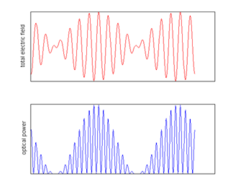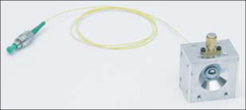Motivation
The THz range is a spectral region with increasing scientific and technological interest. Unfortunately, there is a lack of a coherent continuous-wave THz source being at the same time cost-effective, tunable, powerful, spectrally pure and having a narrow line width and showing a clean radiation characteristics. The term "THz gap" has been coined to illustrate this fact.
Among the wide range of applications in the THz range such as imaging, security, short-range broadband communications and biomedical imaging and diagnostics, we focus our work on the development of a THz source as a local oscillator (LO) for radio astronomical heterodyne receivers. While the current goal of our development is a flightworthy LO channel for integration into GREAT, a first field application was already executed at 1.05 THz at our APEX submm telescope
General technical description:

The total electric field that illuminates the active area of a photo-mixer consists on the sum of two detuned lasers. The photo-current in the device is proportional to the optical power, hence the difference frequency between both laser signals. This beat frequency can be easily tuned over a huge frequency range (DC - several THz). This signal is coupled to free space through a monolithic integrated planar antenna.
A photomixer is an optoelectronic device designed for optical heterodyning, i.e. for the generation of an electrical beat-note from the interference of two optical monochromatic signals -lasers- impinging on a dc biased semiconductor material which absorbs the light. In the absorption process, electron-hole pairs are generated. These are separated by the electric field between two dc biased electrodes, thereby creating a photocurrent proportional to the optical intensity. The ultra-short electron lifetimes of the photomixer material, allowing the photocurrent to ”follow” the envelope of the optical instantaneous power. This contains the laser difference frequency component. The photomixer feeds a planar antenna which is designed to optimally radiate the difference frequency component.

Photo of the pigtailed photomixer. Our high performance/durability fiber pigtail enables operation over a wide temperature range - from room temperature to cryogenic operation at 4K.

